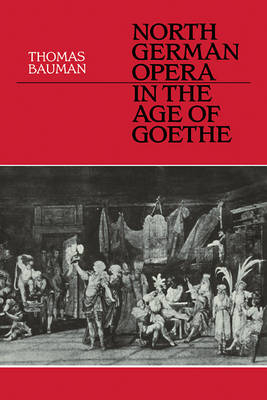
North German Opera in the Age of Goethe
Seiten
2009
Cambridge University Press (Verlag)
978-0-521-11215-4 (ISBN)
Cambridge University Press (Verlag)
978-0-521-11215-4 (ISBN)
This book is the first study of the development of German opera in northern Germany from the first comic operas of Johann Adam Hiller at Leipzig in 1766 to the end of the century. Intellectually and historically German opera was an inseparable part of the new aspirations of the German stage during the Enlightenment.
This book is the first study of the development of German opera in northern Germany from the first comic operas of Johann Adam Hiller at Leipzig in 1766 to the end of the century. Intellectually and historically, the period witnessed the flowering of the German stage and German letters. German opera was an inseparable part of the new aspirations of the German stage during the Enlightenment. Thomas Bauman stresses the vital role of the mixed repertories of German companies in effecting changes in the genre. North German opera began as a basically literary genre. It then changed dramatically in response to two major trends: first, the contact with the serious elements and styles of tragedy and secondly, the triumph on German stages of Italian, French, and Viennese comic operas. The book is generously illustrated with music examples. There is also a complete catalogue of texts of North German opera: those composed for performance and unset published librettos both cross-indexed under the librettists' names.
This book is the first study of the development of German opera in northern Germany from the first comic operas of Johann Adam Hiller at Leipzig in 1766 to the end of the century. Intellectually and historically, the period witnessed the flowering of the German stage and German letters. German opera was an inseparable part of the new aspirations of the German stage during the Enlightenment. Thomas Bauman stresses the vital role of the mixed repertories of German companies in effecting changes in the genre. North German opera began as a basically literary genre. It then changed dramatically in response to two major trends: first, the contact with the serious elements and styles of tragedy and secondly, the triumph on German stages of Italian, French, and Viennese comic operas. The book is generously illustrated with music examples. There is also a complete catalogue of texts of North German opera: those composed for performance and unset published librettos both cross-indexed under the librettists' names.
1. Introduction; 2. The birth of Saxon opera; 3. The diffusion of Saxon opera; 4. New directions: the Seyler company; 5. Prussian stirrings and Goethe's early librettos; 6. Prussian dominion and the end of Saxon opera; 7. Lean years: 1784–1791; 8. The assimilation of Southern styles; Catalogue of North German operas, 1766–1799; Selective bibliography; Index.
| Erscheint lt. Verlag | 11.6.2009 |
|---|---|
| Zusatzinfo | Worked examples or Exercises |
| Verlagsort | Cambridge |
| Sprache | englisch |
| Maße | 152 x 229 mm |
| Gewicht | 670 g |
| Themenwelt | Kunst / Musik / Theater ► Musik ► Klassik / Oper / Musical |
| Kunst / Musik / Theater ► Musik ► Musikgeschichte | |
| ISBN-10 | 0-521-11215-X / 052111215X |
| ISBN-13 | 978-0-521-11215-4 / 9780521112154 |
| Zustand | Neuware |
| Haben Sie eine Frage zum Produkt? |
Mehr entdecken
aus dem Bereich
aus dem Bereich
wie wir unsere Musikkultur retten
Buch | Hardcover (2023)
Frankfurter Allgemeine Buch (Verlag)
CHF 38,90


